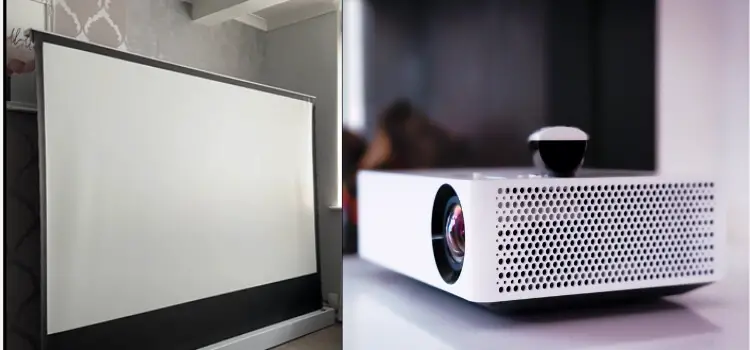As an Amazon Associate I earn from qualifying purchases.

When setting up a projector, many people overlook the screen’s importance. They focus solely on the projector’s specifications and need to realize that the screen can significantly impact the quality of the projected image. To answer the question, “Does the projector screen matter?” the answer is a resounding yes.
Does the Projector Screen Matter?
The answer is a resounding yes! The projector screen does matter, and here’s why:
1. Image Clarity and Sharpness: A high-quality projector screen ensures optimal image clarity and sharpness. The screen’s surface is designed to reflect light evenly, reducing hotspots and providing a uniform brightness distribution across the entire image. This results in a sharper and more detailed picture, allowing you to enjoy the projected content fully.
2. Color Accuracy: The type of screen material used can significantly affect color accuracy. Some screens are specifically engineered to enhance color reproduction, providing a more vibrant and true-to-life image. With a quality projector screen, you can expect accurate and vivid colors that genuinely bring your movies, presentations, or games to life.
3. Contrast and Black Levels: Projector screens are designed to improve contrast and black levels, crucial for creating a visually striking image. A screen with high contrast ratio capabilities will enhance the difference between light and dark areas, resulting in a more immersive viewing experience. This is especially important when watching movies with dark scenes or playing games with high-contrast visuals.
4. Viewing Angle: Another factor to consider is the screen’s viewing angle. A wide viewing angle ensures that everyone in the room can enjoy a clear and distortion-free image, regardless of their seating position. A quality projector screen will have an optimal viewing angle, allowing everyone an optimal viewing experience.
The Role of Projector Screens
Projector screens act as a canvas for the projected image, providing a flat and optimized surface for reflection. They enhance contrast, color accuracy, and the overall visual experience. Without a proper screen, the picture may appear washed out, lack sharpness, and have poor viewing angles.
Screen Material and Its Impact on Image Quality
The choice of screen material is crucial in determining the image quality. Different materials have varying levels of reflectivity, gain, and viewing angles. Some popular screen materials include white matte, high-contrast gray, and ambient light rejection (ALR) screens.
Gain: Understanding Brightness and Reflection
Gain refers to the screen’s ability to reflect light onto the audience. A higher-gain screen reflects more light, resulting in a brighter image. However, high-gain screens can amplify the projector’s imperfections and create hotspots. On the other hand, lower-gain screens provide a wider viewing angle. Still, they may require a more powerful projector in well-lit environments.
Aspect Ratio: Matching the Screen with Projector
The aspect ratio is an essential consideration when choosing a projector screen. It determines the screen’s width and height proportions. Aspect ratios that are most common are 4:3 (standard), 16:9 (widescreen), and 2.35:1 (cinema). Matching the screen’s aspect ratio with the projector ensures the image is displayed correctly without distortion.
Size Matters: Finding the Perfect Fit
The screen size is another critical factor in optimizing the viewing experience. The screen should be large enough to accommodate the desired audience while maintaining a comfortable viewing distance. A screen that is too small can make it difficult for everyone to see the content clearly, while a huge screen may strain the viewer’s neck and eyes.
The Different Types of Projector Screens

Now that we understand the importance of a projector screen, let’s explore the different types available on the market:
1. Fixed Frame Screens
Fixed frame screens are permanently mounted to a wall or frame and do not retract. They are known for providing a flat, taut surface that eliminates any wrinkles or waves. These screens are ideal for dedicated home theaters or conference rooms where a permanent setup is preferred.
2. Motorized Screens
Motorized screens are retractable and conveniently rolled up or down using an electric motor. This type of screen offers flexibility as it can be hidden when not in use, creating a clean and clutter-free space. Motorized screens are popular for multipurpose rooms or areas with limited wall space.
3. Portable Screens
Portable screens are lightweight and easy to transport, making them suitable for presentations on the go. These screens are typically made of foldable fabric or a collapsible frame. Portable screens are an excellent choice for businesses or individuals who frequently travel and require a mobile projection solution.
4. Ambient Light Rejecting (ALR) Screens
ALR screens are designed to combat ambient light in the room, making them an excellent choice for spaces with high natural or artificial light levels. These screens have a unique surface that reflects only the projected light, minimizing the impact of external light sources. ALR screens enhance image contrast and ensure a vibrant image even in bright environments.
Choosing the Right Screen for Different Environments
The optimal projector screen will vary depending on the environment in which it will be used. Here are a few scenarios and the recommended screen types:
- Home theater: fixed frame or motorized screens for dedicated spaces.
- Office presentations: portable screens for mobility and convenience.
- Well-lit rooms: ALR screens to combat ambient light.
- Outdoor events: inflatable screens for large-scale projections.
Maintenance and Cleaning Tips
Regular maintenance and cleaning are crucial for your projector screen’s long-term stability and best performance. Observe the following advice:
- The screen should be carefully cleaned with a gentle, lint-free cloth.
- Avoid using harsh chemicals or abrasive materials.
- Follow the manufacturer’s instructions for cleaning specific screen materials.
- Store the screen in a safe place when not in use to prevent damage.
Projector Screen vs. Wall: Pros and Cons
While some may consider projecting directly onto a wall, a dedicated projector screen offers several advantages. Let’s examine the pros and cons of each choice:
Projector Screen
PROS
CONS
Wall
PROS
CONS
Conclusion
In conclusion, the projector screen does matter when achieving an optimal viewing experience. The right screen can significantly enhance image clarity, color accuracy, contrast, and viewing angles. Whether you are setting up a home theater or a professional presentation room, investing in a high-quality projector screen is essential to unlocking the full potential of your projector. So, pay attention to the importance of the screen when planning your audiovisual setup.
Remember, the type of projector screen you choose should align with your specific needs and preferences. Consider factors such as screen type, material, installation options, and ambient light conditions to make an informed decision. Selecting the right projector screen can elevate your viewing experience to new heights.
FAQs About Projector Screens
Absolutely. The screen material can significantly impact image quality, including brightness, color accuracy, and contrast.
While using a white wall as a makeshift projector screen is possible, it won’t provide the same image quality and performance as a dedicated projector screen.
Yes, most projector screens come with installation instructions and can be easily set up by following the guidelines.
Projector screens can be cleaned using a soft cloth or brush and mild cleaning solutions. Following the manufacturer’s instructions for proper cleaning and maintenance is essential.
Specific projector screens are designed to enhance 3D viewing by maintaining image polarization and minimizing cross-talk between the left and right eye images.
To accommodate different content formats, yes, projector screens are available in various aspect ratios, including 4:3, 16:9, and 2.35:1.
Amazon and the Amazon logo are trademarks of Amazon.com, Inc, or its affiliates.
Leave a Reply